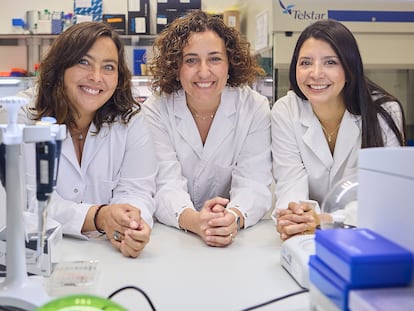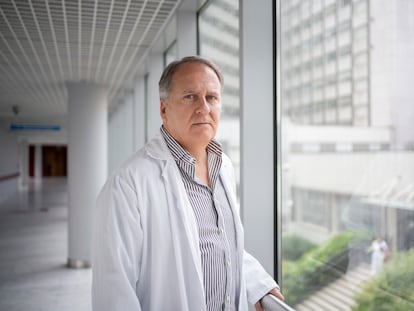Gender inequalities worsen women’s access to cancer prevention, detection and care
A study in ‘The Lancet’ indicates that 1.5 million deaths could be avoided through early detection strategies, while another 800,000 could be averted if all women had access to optimal treatment

Cancer affects men and women differently. But these differences are not always reflected in cancer research and treatment. A report published Tuesday in the scientific journal The Lancet calls for the disease to be addressed from an intersectional gender approach. The authors of the study — a commission made up of international researchers — proposes a set of ten actions, with the general recommendation that sex and gender be included in all cancer-related policies and guidelines.
“This commission was created to investigate the intersection between social inequalities, the status of women in society and cancer,” Karla Unger, researcher in Health Systems at the National Cancer Institute of Mexico and one of the authors of the study, tells EL PAÍS by email. “Those in positions of power decide what is prioritized, financed and studied,” she says, referring to the highly masculinized medical sector. Although she recognizes recent advances, she argues that women with cancer continue to experience “various forms of discrimination” that must be eradicated.
The study was carried out across very different countries, but Unger believes that this does not detract from the research’s value, but rather strengthens its thesis. To highlight the global nature of the problem, Unger frequently points out that these issues are also occurring “in high-income countries.” The report highlights that, “regardless of geographic region or economic resources,” women are more likely than men to lack the knowledge and power to make informed health care decisions.
Access to accurate health information and quality health services is at the center of the analysis. The report notes that 1.5 million women’s deaths could be avoided through primary prevention or early detection strategies, and another 800,000 if all women had access to optimal cancer care. It does not specify the data regarding men.
The research also analyzes the role of women in healthcare and care-giving roles with respect to cancer, reaching the conclusion that in most cases, women become unpaid caregivers when a family member suffers from cancer. And, conversely, they are significantly underrepresented as leaders in cancer research and policy organizations.
Incomplete studies
When talking about cancer and women, the debate generally focuses on cancers that specifically affect them, such as breast and uterine cancer. “Breast cancer is the most common and cervical cancer is the only cancer that is completely preventable,” says Unger. It is normal that these diseases have a lot of media attention. But other types of cancer that affect both sexes were studied by the commission, with the goal of identifying social differences between them. “There are studies that report that women are diagnosed at more advanced stages than men in colorectal cancer, bladder cancer and urinary tract cancer,” Unger explains. “Longer times between going to a doctor and final diagnosis have also been noted for women compared with men for several types of cancer: lung, colorectal, bladder, pancreatic, and urothelial [bladder].”
The study also emphasizes the need to differentiate between gender and sex, something that is not always done. Sex refers to biological attributes such as chromosomes, gene expression and reproductive anatomy. Gender, on the other hand, is a social construction that encompasses the roles and behaviors that are considered socially appropriate for women or men. “These terms are not interchangeable,” Unger clarifies. “But in the research work we did, most of the data available used sex and gender interchangeably, usually in a binary way: male or female. One of the main recommendations we make at the commission is to ensure the routine collection of data disaggregated by sex, gender, and other sociodemographic factors in health statistics.”
Dr. Elena Élez is an oncologist at the Vall d’Hebron University Hospital in Spain and head of the Colorectal Cancer Group at the Vall d’Hebron Institute of Oncology. She did not participate in the study, but her team has published reports with similar findings, and she strongly agrees with its conclusions. Élez praises the wide scope of the report and the fact that it takes into account all stages, from cancer research to patient treatment. She gives two concrete examples of how differentiating between men and women when we talk about cancer can help. “For example, when we do studies and in the models we use little mice,” she explains by phone. “Often the authors do not pay attention to something as simple as specifying whether they are using little female mice or little male mice. And this has a very important impact. The effect of a drug differs according to sex.”
“On the other hand, in medications, data on side effects is usually given in aggregate. Maybe we should differentiate between [the side effects for] men and women and see the impact this has,” she adds. There is scientific literature that supports this idea. An American study published in the Journal of Clinical Oncology reveals that, after receiving cancer treatment, women have a 34% higher risk of developing serious symptomatic adverse effects than men. Above all, if the treatment is immunotherapy: before drugs such as cisplatin or pembrolizumab were approved, women had a 49% higher risk of side effects than men.
“There is a clear male bias in the way we look at the world,” says Ana Porroche Escudero, anthropologist and researcher in the Health Research Division at Lancaster University. “That is why I am pleased that the article mentions the importance of investigating environmental and occupational factors in the incidence of cancer.” When understanding how cancer affects men and women, biological differences must be taken into account, but also environmental differences, she says. These include family responsibilities, the way of responding to pain, following medical prescriptions, the frequency with which check-ups are done.
Porroche believes The Lancet study could have placed “greater emphasis on denouncing the role of social determinants of health in [cancer] incidence,” but is pleased that it focuses on the intersection between power, cancer, and women — a debate that, she believes, has not been fully addressed in the biomedical sector. “Patriarchy dominates cancer research and policymaking,” she says. “Leadership positions are dominated by men and by male thinking. This applies to the management of health services as well as research teams, the committees in charge of subsidizing research and of editing scientific journals,” she says.
Dr. Élez is less critical. “Fortunately, at least in our [Spanish] context, we have a healthcare system that always tries to do the best for the patient, that works based on evidence, and applies the best possible treatment to the patient,” she says. “But we have to understand how we approach this, even the way we talk has to change.” Élez also includes these conclusions in the need to individualize the patient treatment. She explains: “The way of approaching cancer is very different depending on the patient, whether they are male or female, young or old.” In short, we must move towards more individualized and personalized treatment.
Sign up for our weekly newsletter to get more English-language news coverage from EL PAÍS USA Edition
Tu suscripción se está usando en otro dispositivo
¿Quieres añadir otro usuario a tu suscripción?
Si continúas leyendo en este dispositivo, no se podrá leer en el otro.
FlechaTu suscripción se está usando en otro dispositivo y solo puedes acceder a EL PAÍS desde un dispositivo a la vez.
Si quieres compartir tu cuenta, cambia tu suscripción a la modalidad Premium, así podrás añadir otro usuario. Cada uno accederá con su propia cuenta de email, lo que os permitirá personalizar vuestra experiencia en EL PAÍS.
¿Tienes una suscripción de empresa? Accede aquí para contratar más cuentas.
En el caso de no saber quién está usando tu cuenta, te recomendamos cambiar tu contraseña aquí.
Si decides continuar compartiendo tu cuenta, este mensaje se mostrará en tu dispositivo y en el de la otra persona que está usando tu cuenta de forma indefinida, afectando a tu experiencia de lectura. Puedes consultar aquí los términos y condiciones de la suscripción digital.
More information
Archived In
Últimas noticias
There is as much life left to discover on planet Earth as that which is already known
Dozens presumed dead, around 100 injured in fire at Swiss Alps bar during New Year’s celebration
Is porn for women different from conventional porn? We spoke to those who make it
Cartagena de Indias is sinking: What can the city do to mitigate it?
Most viewed
- Sinaloa Cartel war is taking its toll on Los Chapitos
- Reinhard Genzel, Nobel laureate in physics: ‘One-minute videos will never give you the truth’
- David King, chemist: ‘There are scientists studying how to cool the planet; nobody should stop these experiments from happening’
- Oona Chaplin: ‘I told James Cameron that I was living in a treehouse and starting a permaculture project with a friend’
- The Interoceanic Train, the Mexican alternative to the Panama Canal











































